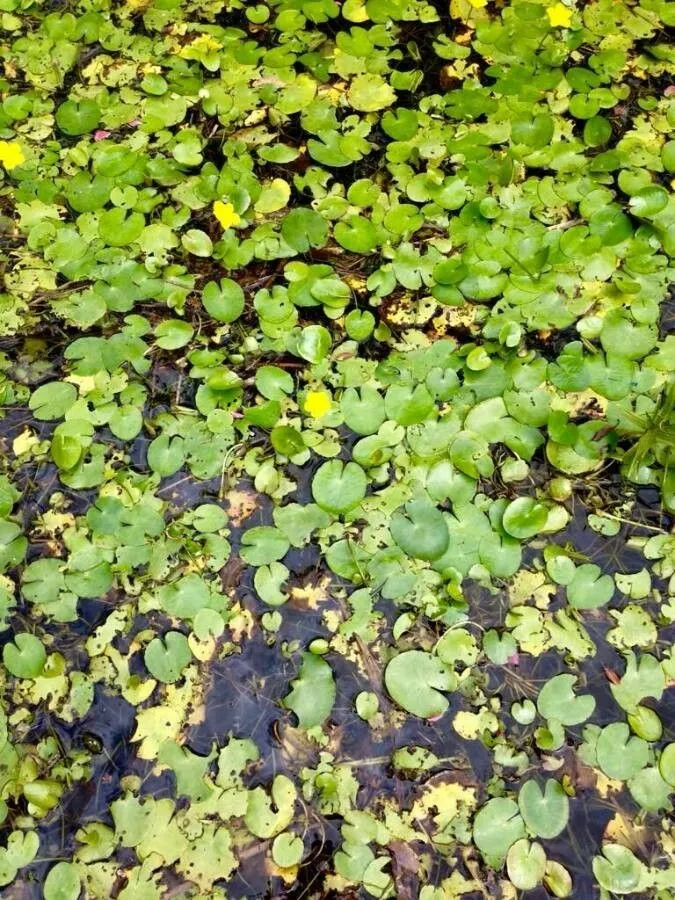
Author: (S.G.Gmel.) Kuntze
Bibliography: Revis. Gen. Pl. 2: 429 (1891)
Year: 1891
Status: accepted
Rank: species
Genus: Nymphoides
Vegetable: False
Observations: Temp. Eurasia, Algeria
Yellow floatingheart, known scientifically as Nymphoides peltata, is a captivating aquatic plant belonging to the Menyanthaceae family. This plant, recognized and classified by the botanist (S.G.Gmel.) Kuntze in the seminal work “Revis. Gen. Pl. 2: 429” published in 1891, is distinguished by its vibrant, sunny-yellow flowers that float gracefully on the surface of the water.
Native to temperate regions across Eurasia and also found in Algeria, Yellow floatingheart thrives in a variety of freshwater habitats, including ponds, lakes, and slow-moving rivers. It flourishes in warm, sunny environments and can tolerate a range of water conditions, making it a versatile and resilient species.
The plant’s most notable feature is its rounded, heart-shaped leaves, which can be likened to miniature lily pads. These leaves rest on the water’s surface, providing an excellent habitat and food source for aquatic wildlife. Below the surface, the plant’s roots anchor it to the sediment, ensuring stability and nutrient uptake.
Yellow floatingheart produces clusters of bright yellow flowers, each standing proudly above the water on slender stems. These blossoms typically appear in the warmer months and can attract various pollinators, although the plant primarily spreads through vegetative means. The flowers and foliage together create a picturesque scene, making it a popular choice for ornamental water gardens.
Despite its beauty, Yellow floatingheart can become invasive outside its native range, particularly in North America, where it competes with native aquatic species for resources. Its ability to form dense mats can also hinder water flow and affect water quality.
In aquatic ecosystems, Yellow floatingheart plays a significant ecological role, offering shelter and sustenance to numerous aquatic animals. However, careful management is essential to prevent its potential spread into non-native areas, where it could disrupt local biodiversity.
Overall, Nymphoides peltata is a fascinating plant that combines beauty and ecological importance, symbolizing the intricate balance of life in freshwater ecosystems.
Dan: almindelig søblad, søblad
Eng: floating heart, fringed water-lily, fringed-water-lily, yellow floating-heart, yellow floatingheart, water fringe, fringed waterlily
Deu: gewöhnliche seekanne, seekanne, teichenzian
Fra: faux-nénuphar, faux-nymphéa pelté, limnanthème faux-nénuphar, nymphoïdès pelté, petit nénufar
Swe: sjögull
Lav: vairogu palepe
Nld: watergentiaan
Cym: ffaen gors eddïog, lili’r-dŵr eddïog, lilïau’r-dŵr eddïog
En: Yellow floatingheart, Floating heart, Fringed water-lily, Fringed-water-lily, Yellow floating-heart, Water fringe, Fringed Waterlily
Da: Almindelig søblad, Søblad
Nl: Watergentiaan
Fr: Faux-nénuphar, Faux-nymphéa pelté, Limnanthème Faux-Nénuphar, Nymphoïdès pelté, Petit nénufar, Faux Nénuphar, Petit Nénufar pelté, Limnanthème faux nénuphar
De: Gewöhnliche Seekanne, Seekanne, Teichenzian
It: Limnantemio
Lv: Vairogu palepe
Es: Genciana acuática
Sv: Sjögull
Cy: Ffaen Gors Eddïog, Lili’r-Dŵr Eddïog, Lilïau’r-Dŵr Eddïog
Taken Jun 18, 2017 by Yoan MARTIN (cc-by-sa)
Taken Sep 14, 2020 by Dieter Wagner (cc-by-sa)
Taken Sep 26, 2021 by Dieter Wagner (cc-by-sa)
Taken Feb 21, 2018 by Dieter Wagner (cc-by-sa)
Taken Feb 28, 2018 by Dieter Wagner (cc-by-sa)
Taken Sep 14, 2020 by Dieter Wagner (cc-by-sa)
Taken Jul 12, 2019 by Pierre GUDEL (cc-by-sa)
Taken Feb 21, 2018 by Dieter Wagner (cc-by-sa)
Taken Feb 28, 2018 by Dieter Wagner (cc-by-sa)
Taken Feb 28, 2018 by Dieter Wagner (cc-by-sa)
Taken Aug 30, 2021 by Anton Fennema (cc-by-sa)
Taken Sep 12, 2021 by Manū (cc-by-sa)
Taken Sep 26, 2021 by Dieter Wagner (cc-by-sa)
Taken Sep 26, 2021 by Dieter Wagner (cc-by-sa)
Taken Nov 5, 2020 by Dieter Wagner (cc-by-sa)
© copyright of the Board of Trustees of the Royal Botanic Gardens, Kew.
© copyright of the Board of Trustees of the Royal Botanic Gardens, Kew.
© copyright of the Board of Trustees of the Royal Botanic Gardens, Kew.
Taken Aug 9, 2022 by Manon Bounous (cc-by-sa)
Taken Jul 19, 2021 by Ronny Bischof (cc-by-sa)
Taken Sep 10, 2022 by Daniel Dumon (cc-by-sa)
Taken Aug 15, 2006 by Photoflora – Bernard TILLY (©)
Taken Aug 15, 2006 by Photoflora – Benoit BOCK (©)
Taken Aug 15, 2006 by Photoflora – Benoit BOCK (©)
Taken Oct 15, 2018 by Photoflora – Benoit BOCK (©)
Taken Oct 15, 2018 by Photoflora – Benoit BOCK (©)
Taken Aug 15, 2017 by Photoflora – Jean-Luc TASSET (©)
Taken Jan 1, 1970 by Photoflora – L’Abbé COSTE (©)
Growth habit: Forb/herb
Ph maximum: 7.0
Ph minimum: 6.5
Light: 9
Atmospheric humidity: 9
Bloom months: [‘jun’, ‘jul’, ‘aug’, ‘sep’]
Soil nutriments: 5
Family: Myrtaceae Author: (F.Muell.) K.D.Hill & L.A.S.Johnson Bibliography: Telopea 6: 402 (1995) Year: 1995 Status:…
Family: Rubiaceae Author: Pierre ex A.Froehner Bibliography: Notizbl. Bot. Gart. Berlin-Dahlem 1: 237 (1897) Year:…
Family: Sapindaceae Author: Koidz. Bibliography: J. Coll. Sci. Imp. Univ. Tokyo 32(1): 38 (1911) Year:…
Family: Asteraceae Author: A.Gray Bibliography: Pacif. Railr. Rep.: 107 (1857) Year: 1857 Status: accepted Rank:…
Family: Fabaceae Author: Medik. Bibliography: Vorles. Churpfälz. Phys.-Ökon. Ges. 2: 398 (1787) Year: 1787 Status:…
Family: Aspleniaceae Author: (Cav.) Alston Bibliography: Bull. Misc. Inform. Kew 1932: 309 (1932) Year: 1932…